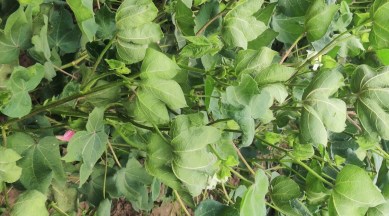Stay updated with the latest - Click here to follow us on Instagram
Whitefly attacks lead to spread of cotton leaf curl disease in Punjab, Haryana, Rajasthan
CLCuD is a viral disease which affects the overall growth of the cotton plant and hits its yield. Leaves of infected cotton curl both upward and downward.

The whitefly attacks have led to the spread of cotton leaf curl disease (CLCuD) across the cotton belt of Punjab, Haryana and Rajasthan, said experts from the Punjab agriculture department and Punjab Agricultural University (PAU) .
CLCuD is a viral disease that affects the overall growth of the cotton plant and hits its yield. Leaves of infected cotton curl both upward and downward. Though farmers are doing recommended sprays, experts said that such sprays are not 100 per cent effective to control the disease.
Experts said that when whiteflies attack the crop, the CLCuD is expected because they transmit the virus further. At the moment, it is very important to control such attacks to check the spread of the disease, they added.
A recent survey conducted by teams of ‘Project Bandhan’, which was launched in by South Asia Biotechnology Centre (SABC) to control the attack of pink bollworm, noticed the CLCuD across Mansa, Bathinda, and Fazilka districts of Punjab, Sirsa and Fatehabad districts of Haryana and Ganganagar and Hanumangarh districts of Rajasthan.
“The SABC teams’ observations were taken on 100 randomly selected plants in each cotton field. It was observed that in all seven districts, the average disease incidence ranged between 4 to 70 per cent. Many plants even showed severe symptoms with upward/downward curling and stunting having higher severity grades,” said Dr Dilip Monga, former head of regional research station, Indian Council of Agricultural Research-Central Institute for Cotton Research (ICAR-CICR), Sirsa, Haryana.
“CLCuD on such a large scale is a matter of concern to the cotton growers. As of now, the cotton crop of all the farmers is above 70 days. During the survey, cotton farmers informed that they have done two or three sprays to control the white flies. Farmers also indicated that they have sown CLCuD-resistant hybrids and even after that the attack of the virus is prevalent,” said Bhagirath Choudhary, founder & director of the SABC.
“Some farmers are spraying insecticide by treating the symptoms of CLCuD as the symptoms of thrips attack. Many farmers are confused between symptoms of CLCuD and thrips attack,” said Dr Deepak Jakhar, a senior research fellow at SABC and a field office, adding that there is a need to develop strong CLCuD-resistant cotton varieties.
Farmer Mahesh Jakhar of village Haripura in Fazilka said that 65 per cent of his crop is under whitefly attack and sprays are not controlling the further spread of the virus.
“The preliminary survey observations have shown that the CLCuV was much higher during the season in north India’s cotton growing areas. Systematic surveys need to be carried out by concerned departments. Moreover, awareness campaigns about the disease and its management are required at an area-wide scale,” said Dr Monga.
Punjab agriculture department director Dr Gurvinder Singh told The Indian Express that he had observed CLCuD across the cotton belt and has been guiding farmers regarding the sprays as the control of white flies is a must to stop the further spread of the disease.
In PAU Ludhiana, sources said that this is an old disease and scientists must develop some CLCuD-resistant seeds instead of depending on the seed of the private companies which claim to sell such seeds.